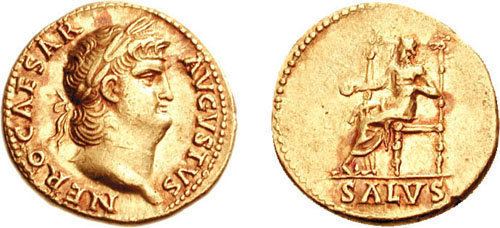 | ||
Salus (Latin: salus, "safety", "salvation", "welfare") was a Roman goddess. She was the goddess of safety and well-being (welfare, health and prosperity) of both the individual and the state. She is sometimes equated with the Greek goddess Hygieia, though her functions differ considerably.
Contents
Salus is one of the most ancient Roman Goddesses: she is also recorded once as Salus Semonia, a fact that might hint to her belonging to the category of the Semones, such as god Semo Sancus Dius Fidius. This view though is disputed among scholars. The issue is discussed in the section below. The two gods had temples in Rome on the Collis Salutaris and Mucialis respectively, two adjacent hilltops of the Quirinal, located in the regio known as Alta Semita. Her temple, as Salus Publica Populi Romani, was voted in 304 BC, during the Samnite wars, by dictator Gaius Junius Bubulcus Brutus, dedicated on 5 August 302 and adorned with frescos at the order of Gaius Fabius Pictor.
The high antiquity and importance of her cult is testified by the little-known ceremony of the Augurium Salutis, held every year on August 5 for the preservation of the Roman state. Her cult was spread over all Italy. Literary sources record relationships with Fortuna and Spes. She started to be increasingly associated to Valetudo, the Goddess of Personal Health, which was the real romanized name of Hygieia.
Later she became more a protector of personal health. Around 180 BCE sacrificial rites in honour of Apollo, Aesculapius, and Salus took place there (Livius XL, 37). There was a statue to Salus in the temple of Concordia. She is first known to be associated with the snake of Aesculapius from a coin of 55 BC minted by M. Acilius. Her festival was celebrated on March 30.
Salus and Sancus
The two deities were related in several ways. Their shrines (aedes) were very close to each other on two adjacent hilltops of the Quirinal, the Collis Mucialis and Salutaris respectively. Some scholars also claim some inscriptions to Sancus have been found on the Collis Salutaris. Moreover, Salus is the first in the series of deities mentioned by Macrobius as related in their sacrality: Salus, Semonia, Seia, Segetia, Tutilina, who required the observance of a dies feriatus of the person who happened to utter their name. These deities were connected to the ancient agrarian cults of the valley of the Circus Maximus that remain mysterious.
German scholars Georg Wissowa, Eduard Norden and Kurt Latte write of a deity named Salus Semonia, who is attested to only in one inscription of year 1 A.D., mentioning a Salus Semonia in its last line (line seventeen). There is consensus among scholars that this line is a later addition and cannot be dated with certainty. In other inscriptions, Salus is never connected to Semonia.
Representation
Salus was often shown seated with her legs crossed (a common position for Securitas), leaning her elbow on the arm of her throne. Often, her right hand holds out a patera (shallow dish used in religious ceremonies) to feed a snake which is coiled round an altar. The snake is reared up and dips its head to the patera.
Sometimes her hand is open and empty, making a gesture. Sometimes the snake directs its gaze along with hers. Sometimes there is no altar; the snake is coiled around the arm of her throne instead.
Occasionally, Salus has a tall staff in her left hand with a snake twined around it; sometimes her right hand raises a smaller female figure. Later, Salus is shown standing, feeding her snake. This became the commonest pose: she is standing and grasping the wriggling snake firmly under her arm, directing it to the food she holds out on a dish in her other hand. Rarely, Salus is holding a steering oar in her left hand (indicates her role in guiding the emperor through a healthy life). This really belongs to Fortuna.
A poem to the Goddess Salus in the African desert
On the construction of the fort of Bu Njem in the African desert (AD 202), centurion Avidius Quintianus dedicated a poem to Goddess Salus in the baths; probably the poem was added directly after the baths were finished. The baths were consecrated to Salus, and we should ask why the centurion chose Goddess Salus to put the baths under her sanction. The Goddess is well adapted to the ordinary life on the site. Moreover, Salus granted not only health but also safety. The choice of Salus could also attract sympathy to the troops at Bu Njem which also would extend to the absent troops. The poem refers to the benefits of Salus such as Salutis lymphas and Salutis gratia. These were not only the waves belonging to Salus but also the benefits of the water and the care for health.
In fact the feeling which dominates the poem is “Solicitude and Friendship”, Solicitude not only towards his home remainders in the camp, but also towards who will succeed him, and friendship towards the fraction of the garrison which departed in operation. The poem runs as follows:
Q Avidius Quintianus- centurio leg(ionis) III Aug(ustae)Faciendum curavitQuaesii multum quot memoriae tradereA gens prae cunctos in hac castra militesVotum communem proque reditu exercitusInter priores et futuros reddereDum quaero mecum digna nominaInveni tandem nomen et numen deaeVotis perennem quem dicare in hoc locoSalutis igitur quandium cultures sientQua potui sanxi nomen et cunctis dediVeras saltis lymphas tantis ignibusIn istis simper harenacis collibusNutantis austri solis flammas fervidasTranquille ut nando delenirent corporaIta tu qui sentis magnam facti gratiamAestuantis animae fucilari spiritumNoli pigere laudem voce reddereVeram qui voluit esse sanum tibiSet protestare vel salutis gratia